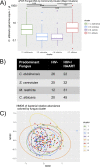Effect of HIV/HAART and Other Clinical Variables on the Oral Mycobiome Using Multivariate Analyses
- PMID: 33758093
- PMCID: PMC8092233
- DOI: 10.1128/mBio.00294-21
Effect of HIV/HAART and Other Clinical Variables on the Oral Mycobiome Using Multivariate Analyses
Abstract
The oral microbiome is considered an important factor in health and disease. We recently reported significant effects of HIV and several other clinical variables on the oral bacterial communities in a large cohort of HIV-positive and -negative individuals. The purpose of the present study was to similarly analyze the oral mycobiome in the same cohort. To identify fungi, the internal transcribed spacer 2 (ITS2) of the fungal rRNA genes was sequenced using oral rinse samples from 149 HIV-positive and 88 HIV-negative subjects that had previously undergone bacterial amplicon sequencing. Quantitative PCR was performed for total fungal content and total bacterial content. Interestingly, samples often showed predominance of a single fungal species with four major clusters predominated by Candida albicans, Candida dubliniensis, Malassezia restricta, or Saccharomyces cerevisiae Quantitative PCR analysis showed the Candida-dominated sample clusters had significantly higher total fungal abundance than the Malassezia or Saccharomyces species. Of the 25 clinical variables evaluated for potential influences on the oral mycobiome, significant effects were associated with caries status, geographical site of sampling, sex, HIV under highly active antiretroviral therapy (HAART), and missing teeth, in rank order of statistical significance. Investigating specific interactions between fungi and bacteria in the samples often showed Candida species positively correlated with Firmicutes or Actinobacteria and negatively correlated with Fusobacteria, Proteobacteria, and Bacteroidetes Our data suggest that the oral mycobiome, while diverse, is often dominated by a limited number of species per individual; is affected by several clinical variables, including HIV positivity and HAART; and shows genera-specific associations with bacterial groups.IMPORTANCE The oral microbiome is likely a key element of homeostasis in the oral cavity. With >600 bacterial species and >160 fungal species comprising the oral microbiome, influences on its composition can have an impact on both local and systemic health. We recently reported significant effects of HIV and several other clinical variables on the oral bacterial community in a large cohort of HIV-positive and -negative subjects. We describe here a comprehensive analysis of the oral mycobiome in the same cohort. Similar to the bacterial community, HIV under highly active antiretroviral therapy (HAART) had a significant impact on the mycobiome composition, but with less impact compared to other clinical variables. Additionally, unlike the oral bacterial microbiome, the oral mycobiome is often dominated by a single species with 4 major clusters of fungal communities. Together, these results suggest the oral mycobiome has distinct properties compared with the oral bacterial community, although both are equally impacted by HIV.
Keywords: Candida; Malassezia; clinical variables; fungal microbiome; human immunodeficiency virus; mycobiome; oral microbiome.
Copyright © 2021 Fidel et al.
Figures





Similar articles
-
The gut mycobiome of the Human Microbiome Project healthy cohort.Microbiome. 2017 Nov 25;5(1):153. doi: 10.1186/s40168-017-0373-4. Microbiome. 2017. PMID: 29178920 Free PMC article.
-
Determinants and Interactions of Oral Bacterial and Fungal Microbiota in Healthy Chinese Adults.Microbiol Spectr. 2022 Feb 23;10(1):e0241021. doi: 10.1128/spectrum.02410-21. Epub 2022 Feb 2. Microbiol Spectr. 2022. PMID: 35107355 Free PMC article.
-
The Salivary Mycobiome Contains 2 Ecologically Distinct Mycotypes.J Dent Res. 2020 Jun;99(6):730-738. doi: 10.1177/0022034520915879. Epub 2020 Apr 21. J Dent Res. 2020. PMID: 32315566 Free PMC article.
-
Critically Appraising the Significance of the Oral Mycobiome.J Dent Res. 2021 Feb;100(2):133-140. doi: 10.1177/0022034520956975. Epub 2020 Sep 13. J Dent Res. 2021. PMID: 32924741 Free PMC article. Review.
-
Mining the oral mycobiome: Methods, components, and meaning.Virulence. 2017 Apr 3;8(3):313-323. doi: 10.1080/21505594.2016.1252015. Epub 2016 Oct 28. Virulence. 2017. PMID: 27791473 Free PMC article. Review.
Cited by
-
Neglected mycobiome in HIV infection: Alterations, common fungal diseases and antifungal immunity.Front Immunol. 2022 Nov 10;13:1015775. doi: 10.3389/fimmu.2022.1015775. eCollection 2022. Front Immunol. 2022. PMID: 36439143 Free PMC article. Review.
-
Fungi and bacteria occupy distinct spatial niches within carious dentin.PLoS Pathog. 2024 May 28;20(5):e1011865. doi: 10.1371/journal.ppat.1011865. eCollection 2024 May. PLoS Pathog. 2024. PMID: 38805482 Free PMC article.
-
RFX transcription factor in the human-associated yeast Candida albicans regulates adhesion to oral epithelium.Mol Microbiol. 2024 Apr;121(4):727-741. doi: 10.1111/mmi.15219. Epub 2024 Jan 6. Mol Microbiol. 2024. PMID: 38183361 Free PMC article.
-
Alterations in the oral microbiome in HIV infection: causes, effects and potential interventions.Chin Med J (Engl). 2021 Oct 20;134(23):2788-2798. doi: 10.1097/CM9.0000000000001825. Chin Med J (Engl). 2021. PMID: 34670249 Free PMC article. Review.
-
Human immunodeficiency virus and oral microbiota: mutual influence on the establishment of a viral gingival reservoir in individuals under antiretroviral therapy.Front Cell Infect Microbiol. 2024 Apr 10;14:1364002. doi: 10.3389/fcimb.2024.1364002. eCollection 2024. Front Cell Infect Microbiol. 2024. PMID: 38660490 Free PMC article. Review.
References
Publication types
MeSH terms
Substances
Grants and funding
LinkOut - more resources
Full Text Sources
Other Literature Sources
Medical

